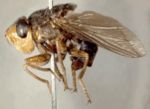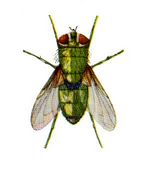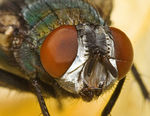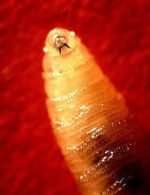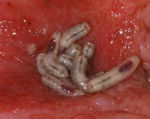Myiasis Producing Flies
Jump to navigation
Jump to search
| This article has been peer reviewed but is awaiting expert review. If you would like to help with this, please see more information about expert reviewing. |
|
|
Introduction
Myiasis is the parasitism of living animals by dipteran larvae. Myiasis can be obligatory or facultative (optional) and is described as cutaneous, nasal or somatic.
Dermatobia hominis
- Also called the human bot fly
- Larvae are important parasites of both humans and animals
- Specifically found in South America
Recognition
- Adult can grow up to 25mm in length
- Similar to Calliphora in appearance
- Blue-black
- Yellow-orange head and legs
- Larvae are distinctive as they taper towards the posterior end
Life cycle
- Eggs laid on blood sucking flies such as mosquitoes
- These hatch when the mosquito next lands on a warm blooded animal
- Larvae penetrate skin causing painful swellings
- Larvae emerge after 35-42 days and fall to ground to pupate
- 4 month life cycle
Pathogenesis
- In humans, the larvae are most often found in swellings on the head and limbs
- Larvae cause painful swellings and distress to cattle
- Larvae cause production losses
- Wounds caused by exiting larvae can increase the prevalence of attack by other myiasis flies
Calliphoridae
- The Calliphoridae family are facultative parasites
- Cause blowfly strike
- If the fly lays eggs on an animal, the animal is said to be blown
- The damage the larvae cause to the animal is known as strike
- Worldwide distribution
- Affects sheep mostly
- Rabbits can also be affected
Species of veterinary importance in Europe
- Lucilia sericata; Greenbottle
- Phormia terra-novae; Blackbottle
- Calliphora erythrocephala; Bluebottle
- Calliphora vomitoria; Bluebottle
Species of veterinary importance in the Tropics
- Lucilia cuprina; South Africa and Australia
- Chrysomya spp.; Africa, Asia and Australia
- Wohlfahrtia; Fleshfly
Recognition of Adults
- Medium sized flies under 10mm long
- Metallic sheen to abdomen
- Colour depends on species
- Clear wings
Recognition of Larvae
- Smooth maggots
- 10-15mm long
- Spiracles and stigmatic plates on the tail can be used for species differentiation
Life cycle
- Eggs laid in wounds, soiled fleece and on carrion
- Females attracted by the odour emitted
- Clusters of yellow-cream eggs laid
- Larvae hatch 24 hours later and crawl down onto the skin
- Feed rapidly
- Grow rapidly
- Moult twice before becoming full maggots
- Process takes 1-2 weeks
- Larvae fall to the ground to pupate
- Adult emerges in under 1 week (during summer)
- The female reaches sexual maturity after a protein meal
- Lays eggs in batches of 100-200
- Adult flies survive for 1 month
- Four generations can develop between May and September
- In warmer climates, up to 9 or 10 generations can develop per year
- Flies can survive the winter as pupae and emerge the next spring
Epidemiology
Blowflies are divided into categories depending on their ability to initiate strike
- Primary flies are capable of initiating a strike on living sheep. Larvae can penetrate intact skin
- Lucilia
- Phormia
- Calliphora spp.
- Secondary flies cannot initiate a strike. Larvae attack an area already struck or damaged, extending it
- Calliphora spp.
- Chrysomya spp. (in warmer climates)
- Tertiary flies attack lesions on carcasses which have become dry
- Musca
- Sarcophaga spp.
Predisposing factors to flystrike
- Temperature
- Temperature in the spring will determine when the overwintering larvae hatch
- High temperature and humidity will create a microclimate in the fleece, attracting adult flies to lay eggs
- Rainfall
- Persistent rainfall will make the fleece microclimate attractive to adult flies. Females lay eggs after the rain ceases
- Breeds with long, fine wool are the most susceptible
- Host susceptibility
- This is increased when putrefactive odours develop on the fleece due to bacterial decomposition of organic matter following soiling with urine or faeces
- Merino sheep have a narrow breech area with excessive wrinkling making them more susceptible to soiling
- A narrow opening of the penile sheath in rams and wethers may result in accumulation of urine and increase blowfly strike in this area
- Cuts during shearing, fighting and barbed wire will also increase the incidence of blowfly strike
Blowfly season
- Temperate regions in June to September
- Mostly in unshorn sheep in June
- Lambs from July to September
- Warmer regions have a more prolonged season due to greater number of blowfly generations
Pathogenesis
- Severe skin damage
- Larvae lacerate skin with oral hooks and liquefy host tissue by secreting proteolytic enzymes
- Skin lesions are extended and deepened
- Secondary blowfly attack
- Flies attracted to odour of decomposing tissue
- Secondary bacterial infection
- Production losses
- Irritation and distress associated with skin lesions
- Poor weight gain (often the first clinical sign)
- Risk of strike is highest in warm, moist weather
Clinical signs
- Anorexia
- Listlessness
- Animals standing apart from flock
- Fleece may appear darker, be damp and have a foul smell
Control
- Prophylactic insecticide treatment
- Must kill larvae and remain in fleece to prevent flies from laying eggs
- Applied by spraying, dipping, spray race or jetting
- Insect growth regulators
- Pour-on
- 2-4 month protection depending upon the product used
- Effective worm control
- To minimise diarrhoea and therefore soiled fleece
- Crutching to prevent soiling
- 'Mule's operation'
- Surgical removal of breech skin in Merino breeds
- Tail docking of lambs
- Proper carcass disposal
- Eliminates fly breeding sites
- Vaccination
- Experimental use against Luculia cuprina in Australia
Screw Worm Myiasis
- C. bezziana cause myiasis in both animals and humans
- Located mainly in tropical regions
- Larvae are obligate parasites
Recognition
- Similar to Calliphora spp.
- Iridescent
- Clear wings
- Blue abdomen
- Longitudinal stripes on thorax
- Larvae have bands of spines
- Look like screws
Life cycle
- Eggs laid in wounds or body cavities
- Larvae feed as colonies
- Larvae drop to the ground to pupate
Pathogenesis
- Spiracles are exposed as larvae feed which expands the wound
- Creates a foul smelling lesion
- Cause irritation and pyrexia
Control
- In the USA
- Mass eradication through the release of sterile males
- Currently only persists where flies have migrated across the Mexican border
- In Africa
- Introduced into Libya through the importation of infested livestock
- Sterile males released
- Eradication occurred in 1991
Maggot Debridement Therapy
- Human medicine
- Sterile Lucilia sericata maggots used to treat infected and necrotic wounds
- Larvae secrete proteolytic enzymes and antimicrobial agents into the wound
- Larvae do not burrow under the skin or attack healthy tissue
- Veterinary medicine
- Published reports rare
- Recently used successfully to treat a suppurative wound in a donkey that did not respond to conventional medical methods and surgery
Wohlfahrtia spp.
- Obligatory parasite
- Occurs in North America
- Parasite of mink and sometimes humans
Recognition
- Large 8-14mm long
- Pale grey
- Black stripes on thorax
- Black spots on abdomen
Life cycle
- Larvae deposited directly onto host
- No egg stage
- Larvae moult twice on host then fall to ground to pupate
Pathogenesis
- Larvae penetrate intact skin
- Cause boil like swellings
